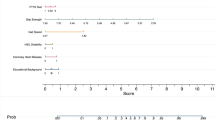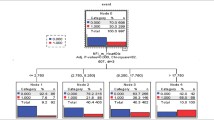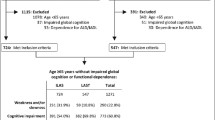Abstract
Objective
This study sought to develop and validate a 6-year risk prediction model in older adults with cognitive frailty (CF).
Methods
In the secondary analysis of Chinese Longitudinal Healthy Longevity Survey (CLHLS), participants from the 2011–2018 cohort were included to develop the prediction model. The CF was assessed by the Chinese version of Mini-Mental State Exam (CMMSE) and the modified Fried criteria. The stepwise regression was used to select predictors, and the logistic regression analysis was conducted to construct the model. The model was externally validated using the temporal validation method via the 2005–2011 cohort. The discrimination was measured by the area under the curve (AUC), and the calibration was measured by the calibration plot. A nomogram was conducted to vividly present the prediction model.
Results
The development dataset included 2420 participants aged 60 years or above, and 243 participants suffered from CF during a median follow-up period of 6.91 years (interquartile range 5.47–7.10 years). Six predictors, namely, age, sex, residence, body mass index (BMI), exercise, and physical disability, were finally used to develop the model. The model performed well with the AUC of 0.830 and 0.840 in the development and external validation datasets, respectively.
Conclusion
The study could provide a practical tool to identify older adults with a high risk of CF early. Furthermore, targeting modifiable factors could prevent about half of the new-onset CF during a 6-year follow-up.
Similar content being viewed by others
Avoid common mistakes on your manuscript.
Background
The global population of older adults was approximately 1 billion in 2019 and will increase to 1.4 billion by 2030 [1]. Ageing contributes to many chronic conditions, such as cognitive impairment and frailty, which have become increasingly significant public health problems [2, 3]. Frailty is influenced by multidomain factors, including age, sex, risk of malnutrition, and chronic diseases, as well as disability [4, 5]. Frailty and cognitive impairment interact in the ageing process, increasing the risk of adverse outcomes [6] such as dementia, disability, and mortality, but they have historically been studied separately. Consequently, the International Consensus Group from the International Academy of Nutrition and Aging (IANA) and the International Association of Gerontology and Geriatrics (IAGG) have proposed that cognitive frailty (CF) is a clinical condition characterized by the occurrence of both physical frailty and cognitive impairment and in the absence of dementia diagnosis [7]. CF may contribute to a higher risk of adverse outcomes than healthy older adults or those with physical frailty or cognitive impairment alone [8,9,10]. A meta-analysis indicated that the pooled prevalence of CF among community-dwelling older adults was 9% [11].
In order to identify individuals at high risk of CF and to facilitate the implementation of appropriate preventive measures and interventions [12,13,14], some prediction models have been developed [15,Candidate predictors Candidate predictors were selected based on previous studies [24,25,26,27,28], medical knowledge and data available in the database. A total of 12 candidate predictors were chosen, and the detailed information is shown in Table 1. The physical disability was measured using the instrumental activity of daily living (IADL) and the basic activity of daily living (BADL), and it was defined if any item of IADL or BADL was judged as dependence [52]. Despite the lack of significant impact on CF, exercise remained a constituent of the final model. The predictors were computed following the AIC methodology and were informed by scientific insights, underscoring the pivotal role of exercise in CF [12, 52]. Our study had some strengths. Firstly, the participants were representative because they were from a large population-based cohort. Secondly, the predictors included were non-invasive, low-cost, and easy to obtain, so the prediction model could be used in the primary care settings [53]. Thirdly, we performed external validation for portability and generalization, and the model displayed excellent discrimination and calibration in external validation. Lastly, we calculated the PAF to explore how modifiable risk factors contribute to CF. Our study also had some limitations. Firstly, most predictors were self-reported by older adults, potentially introducing information bias. Nevertheless, self-reported predictors were more easy-to-obtain and practical [54]. Secondly, some critical predictors were not included due to data limitations, such as depression [28], likely impacting the prediction performance. Thirdly, BMI, a part of the CF assessment, was selected as a predictor, which might introduce incorporation bias and optimist estimates of model performance [55]. However, the sensitivity analysis indicated that after removing the BMI, the prediction model maintained excellent performance. Therefore, the incorporation bias may have a negligible effect on the model performance. This study presents some insights for future research. Firstly, the selection of predictive factors, encompassing easily accessible, non-invasive, and cost-effective variables, plays a pivotal role in prediction models applicable to clinical practice, especially within community healthcare and diverse clinical settings. Subsequent research endeavors should consider integrating addition predictive factors that share the accessibility, non-invasiveness, and cost-effectiveness criteria. Secondly, our study is grounded in the application of the logistic regression method for model development. Future research could explore alternative methodologies, such as machine learning techniques, to foster the evolution of predictive models. Lastly, the model's foundation is rooted in the Chinese population, prompting the necessity to examine its transferability to other demographics. This calls for comprehensive validation in diverse populations to establish its broader applicability in the future. This study developed a prediction model for CF based on the characteristics of the Chinese population, utilizing practical, non-invasive, cost-effective, and easily obtainable variables. It can be applied in secondary prevention, enabling early identification, diagnosis, and treatment of CF. In tertiary disease prevention, the predictive model can be used to forecast recurrence, reduce mortality and disability [56]. Furthermore, it can provide community staffs with insights into the progression of CF in the older adults, allowing the identification of potential contributing factors for tailored preventive interventions [54].Strengths
Limitations
Implications and clinical practice
Conclusion
The CF prediction model, following the TRIPOD statement, has been established and validated for older adults. It integrates six easily obtainable predictors and demonstrates excellent prediction performance. This model helps healthcare practitioners and nurses to identify older adults at a heightened risk of CF development over a six-year period and intervene proactively.
Data availability
The CLHLS data can be obtained by applying on the website. https://opendata.pku.edu.cn/dataset.xhtml?persistentId=doi:10.18170/DVN/WBO7LK&version=2.0.
References
World Health Organization (2018) Ageing. https://www.who.int/news-room/facts-in-pictures/detail/ageing. Accessed 28 Feb 2018
Dent E, Lien C, Lim WS et al (2017) The Asia-Pacific clinical practice guidelines for the management of frailty. J Am Med Dir Assoc 18:564–575. https://doi.org/10.1016/j.jamda.2017.04.018
Yu R, Wong M, Chong KC et al (2018) Trajectories of frailty among Chinese older people in Hong Kong between 2001 and 2012: an age-period-cohort analysis. Age Ageing 47:254–261. https://doi.org/10.1093/ageing/afx170
Qin Y, Hao X, Lv M et al (2023) A global perspective on risk factors for frailty in community-dwelling older adults: a systematic review and meta-analysis. Arch Gerontol Geriatr 105:104844. https://doi.org/10.1016/j.archger.2022.104844
He B, Ma Y, Wang C et al (2019) Prevalence and risk factors for frailty among community-dwelling older people in china: a systematic review and meta-analysis. J Nutr Health Aging 23:442–450. https://doi.org/10.1007/s12603-019-1179-9
Lee Y, Kim J, Chon D et al (2018) The effects of frailty and cognitive impairment on 3-year mortality in older adults. Maturitas 107:50–55. https://doi.org/10.1016/j.maturitas.2017.10.006
Kelaiditi E, Cesari M, Canevelli M et al (2013) Cognitive frailty: rational and definition from an (i.A.N.A./i.A.G.G.) international consensus group. J Nutr Health Aging 17:726–734. https://doi.org/10.1007/s12603-013-0367-2
Chen C, Park J, Wu C et al (2020) Cognitive frailty in relation to adverse health outcomes independent of multimorbidity: results from the china health and retirement longitudinal study. Aging (Albany NY) 12:23129–23145. https://doi.org/10.18632/aging.104078
Shimada H, Doi T, Lee S et al (2018) Cognitive frailty predicts incident dementia among community-dwelling older people. J Clin Med. https://doi.org/10.3390/jcm7090250
Zhang XM, Jiao J, Zhu C et al (2021) Cognitive frailty and 30-day mortality in a national cohort of older Chinese inpatients. Clin Interv Aging 16:389–401. https://doi.org/10.2147/cia.S294106
Qiu Y, Li G, Wang X et al (2022) Prevalence of cognitive frailty among community-dwelling older adults: a systematic review and meta-analysis. Int J Nurs Stud 125:104112. https://doi.org/10.1016/j.ijnurstu.2021.104112
Merchant RA, Chan YH, Hui RJY et al (2021) Motoric cognitive risk syndrome, physio-cognitive decline syndrome, cognitive frailty and reversibility with dual-task exercise. Exp Gerontol 150:111362. https://doi.org/10.1016/j.exger.2021.111362
Ruan Q, Yu Z, Chen M et al (2015) Cognitive frailty, a novel target for the prevention of elderly dependency. Ageing Res Rev 20:1–10. https://doi.org/10.1016/j.arr.2014.12.004
Hoogendijk EO, Afilalo J, Ensrud KE et al (2019) Frailty: implications for clinical practice and public health. Lancet 394:1365–1375. https://doi.org/10.1016/s0140-6736(19)31786-6
Huang J, Zeng X, Hu M et al (2023) Prediction model for cognitive frailty in older adults: A systematic review and critical appraisal. Front Aging Neurosci 15:1119194. https://doi.org/10.3389/fnagi.2023.1119194
Peng S, Zhou J, **ong S et al (2023) Construction and validation of cognitive frailty risk prediction model for elderly patients with multimorbidity in Chinese community based on non-traditional factors. BMC Psychiatry 23:266. https://doi.org/10.1186/s12888-023-04736-6
Sargent L, Nalls M, Amella EJ et al (2020) Shared mechanisms for cognitive impairment and physical frailty: a model for complex systems. Alzheimers Dement (N Y) 6:e12027. https://doi.org/10.1002/trc2.12027
Collins GS, Reitsma JB, Altman DG et al (2015) Transparent reporting of a multivariable prediction model for individual prognosis or diagnosis (tripod): the tripod statement. BMJ 350:g7594. https://doi.org/10.1136/bmj.g7594
Zhang XX, Tian Y, Wang ZT et al (2021) The epidemiology of Alzheimer’s disease modifiable risk factors and prevention. J Prev Alzheimers Dis 8:313–321. https://doi.org/10.14283/jpad.2021.15
Folstein MF, Folstein SE, McHugh PR (1975) “Mini-mental state”. A practical method for grading the cognitive state of patients for the clinician. J Psychiatr Res 12:189–198. https://doi.org/10.1016/0022-3956(75)90026-6
Luo G, Han J, QQ et al (2002) The suitable application the mmse on old people in urban and rural areas [Chinese]. Chin J Clin Psychol 01:10–13
Yang Z, Holt HK, Fan J-H et al (2016) Optimal cutoff scores for alzheimer’s disease using the chinese version of mini-mental state examination among chinese population living in rural areas. Am J Alzheimers Dis Other Demen 31:650–657. https://doi.org/10.1177/1533317516662336
Wang HY, Lv X, Du J et al (2021) Age- and gender-specific prevalence of frailty and its outcomes in the longevous population: the Chinese longitudinal healthy longevity study. Front Med (Lausanne) 8:719806. https://doi.org/10.3389/fmed.2021.719806
Chen Y, Zhang Z, Zuo Q et al (2022) Construction and validation of a prediction model for the risk of cognitive frailty among the elderly in a community [Chinese]. Chin J Nurs 57:197–203. https://doi.org/10.3761/j.issn.0254-1769.2022.02.012
Tseng SH, Liu LK, Peng LN et al (2019) Development and validation of a tool to screen for cognitive frailty among community-dwelling elders. J Nutr Health Aging 23:904–909. https://doi.org/10.1007/s12603-019-1235-5
Wen F, Chen M, Zhao C et al (2021) Development of a cognitive frailty prediction model for elderly patients with stable coronary artery disease [Chinese]. J Nurs Sci 36:21–26. https://doi.org/10.3870/j.issn.1001-4152.2021.10.021
Yang Z, Zhang H (2021) A nomogram for predicting the risk of cognitive frailty in community-dwelling elderly people with chronic diseases [Chinese]. J Nurs Sci 36:86–89. https://doi.org/10.3870/j.issn.1001-4125.2021.12.086
Zhang T, Ren Y, Shen P et al (2021) Prevalence and associated risk factors of cognitive frailty: a systematic review and meta-analysis. Front Aging Neurosci 13:755926. https://doi.org/10.3389/fnagi.2021.755926
Zhang Y, **ong Y, Yu Q et al (2021) The activity of daily living (adl) subgroups and health impairment among Chinese elderly: a latent profile analysis. BMC Geriatr 21:30. https://doi.org/10.1186/s12877-020-01986-x
Wolff RF, Moons KGM, Riley RD et al (2019) Probast: a tool to assess the risk of bias and applicability of prediction model studies. Ann Intern Med 170:51–58. https://doi.org/10.7326/m18-1376
Steyerberg EW (2009) Clinical prediction models: a practical approach to development, validation, and updating. Springer, Cham
Gao M, Wei YX, Lyu J et al (2019) the cut-off points of body mass index and waist circumference for predicting metabolic risk factors in Chinese adults. Zhonghua Liu **ng Bing Xue Za Zhi 40:1533–1540. https://doi.org/10.3760/cma.j.issn.0254-6450.2019.12.006
Alba AC, Agoritsas T, Walsh M et al (2017) Discrimination and calibration of clinical prediction models: Users’ guides to the medical literature. JAMA 318:1377–1384. https://doi.org/10.1001/jama.2017.12126
Mandrekar JN (2010) Receiver operating characteristic curve in diagnostic test assessment. J Thorac Oncol 5:1315–1316. https://doi.org/10.1097/JTO.0b013e3181ec173d
Steyerberg EW, Vickers AJ, Cook NR et al (2010) Assessing the performance of prediction models: a framework for traditional and novel measures. Epidemiology 21:128–138. https://doi.org/10.1097/EDE.0b013e3181c30fb2
Vatanabe IP, Pedroso RV, Teles RHG et al (2022) A systematic review and meta-analysis on cognitive frailty in community-dwelling older adults: risk and associated factors. Aging Ment Health 26:464–476. https://doi.org/10.1080/13607863.2021.1884844
Robertson DA, Savva GM, Kenny RA (2013) Frailty and cognitive impairment—a review of the evidence and causal mechanisms. Ageing Res Rev 12:840–851. https://doi.org/10.1016/j.arr.2013.06.004
Muller M, Grobbee DE, Thijssen JH et al (2003) Sex hormones and male health: effects on components of the frailty syndrome. Trends Endocrinol Metab 14:289–296. https://doi.org/10.1016/s1043-2760(03)00083-3
Maggio M, Dall’Aglio E, Lauretani F et al (2012) The hormonal pathway to cognitive impairment in older men. J Nutr Health Aging 16:40–54. https://doi.org/10.1007/s12603-012-0002-7
Ma L, Tang Z, Zhang L et al (2018) Prevalence of frailty and associated factors in the community-dwelling population of china. J Am Geriatr Soc 66:559–564. https://doi.org/10.1111/jgs.15214
Shimada H, Makizako H, Lee S et al (2016) Impact of cognitive frailty on daily activities in older persons. J Nutr Health Aging 20:729–735. https://doi.org/10.1007/s12603-016-0685-2
Liu H, Jiao J, Zhu C et al (2020) Potential associated factors of functional disability in Chinese older inpatients: a multicenter cross-sectional study. BMC Geriatr 20:319. https://doi.org/10.1186/s12877-020-01738-x
Rietman ML, van der AD, van Oostrom SH et al (2018) The association between bmi and different frailty domains: a u-shaped curve? J Nutr Health Aging 22:8–15. https://doi.org/10.1007/s12603-016-0854-3
Deng YT, Li YZ, Huang SY et al (2022) Association of life course adiposity with risk of incident dementia: A prospective cohort study of 322,336 participants. Mol Psychiatry 27:3385–3395. https://doi.org/10.1038/s41380-022-01604-9
Frodermann V, Rohde D, Courties G et al (2019) Exercise reduces inflammatory cell production and cardiovascular inflammation via instruction of hematopoietic progenitor cells. Nat Med 25:1761–1771. https://doi.org/10.1038/s41591-019-0633-x
Alessa HB, Chomistek AK, Hankinson SE et al (2017) Objective measures of physical activity and cardiometabolic and endocrine biomarkers. Med Sci Sports Exerc 49:1817–1825. https://doi.org/10.1249/mss.0000000000001287
Miller SL, Wolfe RR (2008) The danger of weight loss in the elderly. J Nutr Health Aging 12:487–491. https://doi.org/10.1007/bf02982710
Cesari M, Penninx BW, Pahor M et al (2004) Inflammatory markers and physical performance in older persons: the inchianti study. J Gerontol A Biol Sci Med Sci 59:242–248. https://doi.org/10.1093/gerona/59.3.m242
Luger E, Dorner TE, Haider S et al (2016) Effects of a home-based and volunteer-administered physical training, nutritional, and social support program on malnutrition and frailty in older persons: a randomized controlled trial. J Am Med Dir Assoc 17:671.e679-671.e616. https://doi.org/10.1016/j.jamda.2016.04.018
Hsu KJ, Liao CD, Tsai MW et al (2019) Effects of exercise and nutritional intervention on body composition, metabolic health, and physical performance in adults with sarcopenic obesity: a meta-analysis. Nutrients. https://doi.org/10.3390/nu11092163
Liu Z, Hsu FC, Trombetti A et al (2018) Effect of 24-month physical activity on cognitive frailty and the role of inflammation: the life randomized clinical trial. BMC Med 16:185. https://doi.org/10.1186/s12916-018-1174-8
Li X, Zhang Y, Tian Y et al (2022) Exercise interventions for older people with cognitive frailty-a sco** review. BMC Geriatr 22:721. https://doi.org/10.1186/s12877-022-03370-3
Zhou ZR, Wang WW, Li Y et al (2019) In-depth mining of clinical data: the construction of clinical prediction model with r. Ann Transl Med 7:796. https://doi.org/10.21037/atm.2019.08.63
Hu M, Shu X, Yu G et al (2021) A risk prediction model based on machine learning for cognitive impairment among Chinese community-dwelling elderly people with normal cognition: development and validation study. J Med Internet Res 23:e20298. https://doi.org/10.2196/20298
Moons KGM, Wolff RF, Riley RD et al (2019) Probast: a tool to assess risk of bias and applicability of prediction model studies: explanation and elaboration. Ann Intern Med 170:W1-w33. https://doi.org/10.7326/m18-1377
Langa KM, Levine DA (2014) The diagnosis and management of mild cognitive impairment: A clinical review. JAMA 312:2551–2561. https://doi.org/10.1001/jama.2014.13806
Acknowledgements
The authors thank the work and contribution of all members of the CLHLS.
Funding
This study was supported by the National Natural Science Foundation of China (Grant Numbers: 72374224, 72174212), National Key R&D Program of China (Grant number 2020YFC2008602, 2020YFC2008603), Natural Science Foundation of Hunan province (2023JJ30704), the Special Funding for the Construction of Innovative Provinces in Hunan (2020SK2055), and the Changsha County Science and Technology Plan Project (2022037-2).
Author information
Authors and Affiliations
Corresponding authors
Ethics declarations
Conflict of interest
The authors have no relevant financial or non-financial interests to disclose.
Ethical approval
The CLHLS study was approved by the research ethics committees of Duke University and Peking University (IRB00001052-13074).
Informed consent
For this type of study, consent is not required.
Additional information
Publisher's Note
Springer Nature remains neutral with regard to jurisdictional claims in published maps and institutional affiliations.
Supplementary Information
Below is the link to the electronic supplementary material.
Rights and permissions
Open Access This article is licensed under a Creative Commons Attribution 4.0 International License, which permits use, sharing, adaptation, distribution and reproduction in any medium or format, as long as you give appropriate credit to the original author(s) and the source, provide a link to the Creative Commons licence, and indicate if changes were made. The images or other third party material in this article are included in the article's Creative Commons licence, unless indicated otherwise in a credit line to the material. If material is not included in the article's Creative Commons licence and your intended use is not permitted by statutory regulation or exceeds the permitted use, you will need to obtain permission directly from the copyright holder. To view a copy of this licence, visit http://creativecommons.org/licenses/by/4.0/.
About this article
Cite this article
Huang, J., Zeng, X., Ning, H. et al. Development and validation of prediction model for older adults with cognitive frailty. Aging Clin Exp Res 36, 8 (2024). https://doi.org/10.1007/s40520-023-02647-w
Received:
Accepted:
Published:
DOI: https://doi.org/10.1007/s40520-023-02647-w




